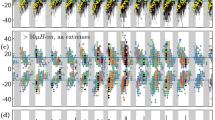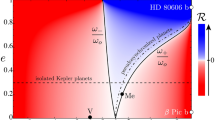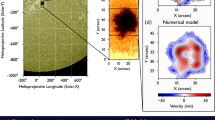Abstract
IT has been proposed1,2 that sunspot activity is affected by positions of the planets, and calculations have been presented3, which purport to show that planetary tides on the Sun vary in the same way as the sunspot variations. We believe that the apparent agreement of the sunspot cycle with planetary tidal effects is an artefact of the calculation.
This is a preview of subscription content, access via your institution
Access options
Subscribe to this journal
Receive 51 print issues and online access
$199.00 per year
only $3.90 per issue
Buy this article
- Purchase on Springer Link
- Instant access to full article PDF
Prices may be subject to local taxes which are calculated during checkout
Similar content being viewed by others
References
Wood, R. M., and Wood, K. D., Nature, 208, 129–131 (1965).
Bigg, E. K., Astr. J., 72, 463–466 (1967).
Wood, K. D., Nature, 240, 91–93 (1972).
JPL Technical Report No. 32–1306, 30–31 (Jet Propulsion Laboratory, Pasadena, California, 1968).
Cohen, T. J., and Lintz, P. R., Nature, 250, 398–400 (1974).
Jose, P. D., Astr. J., 70, 193–200 (1965).
Gribbin, J., and Plagemann, S., The Jupiter Effect (Macmillan, London, 1974).
Author information
Authors and Affiliations
Rights and permissions
About this article
Cite this article
OKAL, E., ANDERSON, D. On the planetary theory of sunspots. Nature 253, 511–513 (1975). https://doi.org/10.1038/253511a0
Received:
Issue Date:
DOI: https://doi.org/10.1038/253511a0
This article is cited by
-
Response to Comment on “Tidally Synchronized Solar Dynamo: A Rebuttal”
Solar Physics (2023)
-
Comment on “Tidally Synchronized Solar Dynamo: A Rebuttal” by Nataf (Solar Phys. 297, 107, 2022)
Solar Physics (2023)
-
Tidal Forcing on the Sun and the 11-Year Solar-Activity Cycle
Solar Physics (2023)
-
Tidally Synchronized Solar Dynamo: A Rebuttal
Solar Physics (2022)
-
On the origin of solar cycle periodicity
Astrophysics and Space Science (1996)
Comments
By submitting a comment you agree to abide by our Terms and Community Guidelines. If you find something abusive or that does not comply with our terms or guidelines please flag it as inappropriate.



